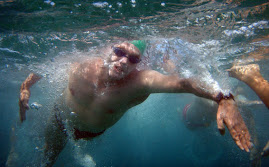Friday, 30 January 2009
10 tips to survive the ocean swims season
Sink or swim?
I'm sure that, having read my first blog entry, you are dying to know my time in the Big Swim.
Oh good. You don't really give a toss.
Suffice to say, I was in the bottom 20 of the 1500 swimmers who completed the course (DNFs were not included in the results). My time was around 15 minutes slower than in 2007. The fastest time was 35.56 and the slowest 1.40.34.
You'll be pleased to know that I have moved on (sort of ... small sob) and am now looking ahead to the next challenge, the 2km Cole Classic. But more on that later.
I have compiled a list of 'must haves' if you are new to or considering ocean swimming as a fun alternative to being stretched on a rack or climbing Mount Everest without wearing gloves (just kidding - out demons!).
Seriously, ocean swimming is an amazing sport if you can recover from the disappointment of constantly finishing at the back of the pack.
Follow these 10 tips and success will surely follow:
1. You must be able to swim. And most important, the stroke must be freestyle/overarm/Aussie Crawl*. If you aren't a competent swimmer you won't even make it to the first buoy.
It always looks like a cinch from the spectator's point-of-view, witnessing the spectacle of 600-1200 swimmers dashing out to sea. The below-average swimmer will struggle if the surf's up and the current is strong.
If you're not a good swimmer, get stroke correction lessons, surfing lessons, etc.
2. Show respect for sea creatures and don't be afraid of them. That includes jelly blubbers, stingrays and sharks. I have participated in ocean swims for almost four years and there has never been an official shark sighting - oh, except off the heads at Manly a couples of years ago! But the organisers of the 10km swim, which was to venture into the sharks' territory, quickly cancelled the event. No worries.
Sea creatures, except for yucky bluebottles (these are my one exception - feel free to fear and loathe these creepy stingy things) are mostly harmless creatures doddling along minding their own business.
3. Worship the surf, admire its power and its glory. Well, that's a bit over the top. But it is important to never underestimate the latent force of the ocean.
It's important to be prepared physically and mentally when the conditions are less than ideal. A strong current can sweep swimmers off course. Rough, dumping surf can hinder progress and lead to exhaustion. Swim in the surf as much as you can so as to better understand its quixotic ways.
If it does get rough out there, don't panic. There's always someone - a fellow swimmer or surflifesaver - there to help you out of a tough spot.
4. Commit to a fitness regime and join a swim squad. The squad is on my list of things 'to do' and I feel that not being in one puts me at a disadvantage. A squad is a big commitment, but I'm sure it leads to better results. You'll train with a group of like-minded people, get fit and make new friends.
5. Learn to navigate. An ocean swim follows a set course which is marked out by a number of buoys. The idea is that you swim around or past the buoys to your destination - the beach. However, if the swell is choppy or the buoys are spaced a fair distance apart, they can be hard to find.
But there are ways to ensure that you don't get lost or swim wide of the buoys. If you're a reasonable swimmer you'll probably stay with the pack, which is great because it becomes a game of follow the leader.
But, if you're a bit of a plodder like me, you might lose the pack and find yourself alone.
Before the swim, it is a good idea to study the course so you know exactly where you are expected to swim. You could also look out for landmarks that will help guide you to the buoys. For example, a row of trees might mark the location of the most distant buoy.
I still swim wide and find myself swimming back into the pack, but I think the more swims you do, the better you get.
6. Get the gear. Ocean swimming is a relatively inexpensive pastime compared to most other sports.
Girls need a tough cossie. I've got a one-piece Speedo Endurance that's lasted three seasons and a new Rival - both good quality. Boys need well-fitting (ie: not saggy-bums) budgie smugglers. No more and no less.
Look for a good pair of goggles that won't leak or fog up and try before buying.
When in training, some women and men prefer to wear caps. This is a personal thing.
Fins and kick boards might be useful for training.
For the swim take along bottled water, a sun cream with a strong SPF, a towel, undies (underwear is handy if there's sea lice around. The little buggers tend to cling to cossies and bite, bite, bite where they can).
7. Use oceanswims.com. This website is the ocean swimmer's bible. It is where I go to find out what's going on in the ocean swimming scene across Australia. Its focus is primarily on NSW, but only because that's where most of the ocean swims are on over the summer months.
However, the site also does a great job covering swims in other states and overseas.
It's also an amazing resource if you're new to the game and seeking advice and information. It has its own blog where members of the ocean swimming community debate a range of issues. Once you're on the oceanswims.com email list, you'll receive the latest updates on upcoming swims and more. I am a dedicated fan.
8. Get a support team. It's always nice to have someone to carry your towel and cheer you over the finish line. I recommend you get several non-swimming friends onboard because they're the ones who will stroke your ego with comments such as: "I could never do that. I think it's amazing that you're even out there having a go!"
Milk it for all it's worth.
9. Develop resilience. I just threw that one in because I like the word 'resilience'.
10. If you don't already have one, get a sense of humour and learn to roll with the punches (and kicks).
Ocean swimming should be fun. It's not a race (unless you're a bloody elite swimmer going for the $1000 prize money or the trip to Hawaii).
It's a sure bet that at some point you will be elbowed, runover, kicked and generally jostled. Don't take it personally. Just be thankful you're a part of it.
It's all about getting out there in the elements, feeling completely alive and having a go with a smile on your melon.
*Just recently there have been complaints from some ocean swimmers about those swimmers who use breaststroke when heading around a buoy. As far as I'm concerned it's a whinge about nothing. Go to oceanswims.com to check out the debate.
Subscribe to:
Post Comments (Atom)




No comments:
Post a Comment